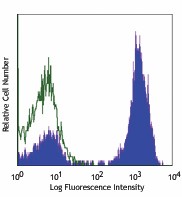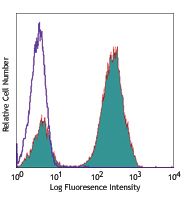- Clone
- IP26 (See other available formats)
- Regulatory Status
- RUO
- Other Names
- α/β TCR, TCR α/β
- Isotype
- Mouse IgG1, κ
- Ave. Rating
- Submit a Review
- Product Citations
- publications

-

Human peripheral blood lymphocytes stained with IP26 APC
| Cat # | Size | Price | Quantity Check Availability | Save | ||
|---|---|---|---|---|---|---|
| 306717 | 25 tests | 91€ | ||||
| 306718 | 100 tests | 200€ | ||||
The IP26 antibody reacts with a monomorphic determinant of the α/β T-cell receptor, which is expressed on greater than 95% of normal peripheral blood CD3+ T cells. The α/β TCR recognizes a peptide bound to MHC leading to T-cell activation.
Product DetailsProduct Details
- Reactivity
- Human
- Antibody Type
- Monoclonal
- Host Species
- Mouse
- Formulation
- Phosphate-buffered solution, pH 7.2, containing 0.09% sodium azide and BSA (origin USA)
- Preparation
- The antibody was purified by affinity chromatography and conjugated with APC under optimal conditions.
- Concentration
- Lot-specific (to obtain lot-specific concentration and expiration, please enter the lot number in our Certificate of Analysis online tool.)
- Storage & Handling
- The antibody solution should be stored undiluted between 2°C and 8°C, and protected from prolonged exposure to light. Do not freeze.
- Application
-
FC - Quality tested
- Recommended Usage
-
Each lot of this antibody is quality control tested by immunofluorescent staining with flow cytometric analysis. For flow cytometric staining, the suggested use of this reagent is 5 µl per million cells in 100 µl staining volume or 5 µl per 100 µl of whole blood.
- Excitation Laser
-
Red Laser (633 nm)
- Application Notes
-
Additional reported applications (for the relevant formats) include: T cell activation. When co-staining with anti-CD3, we recommend using clone UCHT1, since we have confirmed that IP26 does not compete with this clone. Other anti-CD3 clones may compete out the binding of IP26.
- Application References
- Product Citations
- RRID
-
AB_10612747 (BioLegend Cat. No. 306717)
AB_10612569 (BioLegend Cat. No. 306718)
Antigen Details
- Structure
- Ig superfamily, with CD3 forms CD3/TCR complex
- Distribution
-
T cells, thymocytes
- Function
- Antigen recognition, T cell activation
- Ligand/Receptor
- Peptide bound to MHC
- Cell Type
- T cells, Thymocytes, Tregs
- Biology Area
- Adaptive Immunity, Immunology
- Molecular Family
- TCRs
- Antigen References
-
1. Marchalonis J, et al. 2002. J. Mol. Recognit. 15:260.
- Gene ID
- 6955 View all products for this Gene ID 6957 View all products for this Gene ID
- UniProt
- View information about TCR alpha/beta on UniProt.org
Customers Also Purchased
Compare Data Across All Formats
This data display is provided for general comparisons between formats.
Your actual data may vary due to variations in samples, target cells, instruments and their settings, staining conditions, and other factors.
If you need assistance with selecting the best format contact our expert technical support team.
 Login / Register
Login / Register 
















Follow Us